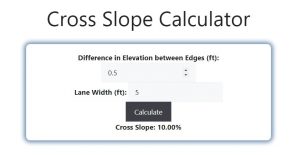About Cross Slope Calculator (Formula)
The Cross Slope Calculator is an essential tool used in various fields, including civil engineering, construction, and landscape design. It helps professionals and enthusiasts assess the slope of surfaces such as roads, driveways, and walking paths. Cross slope refers to the angle or gradient of a surface, which is crucial for proper drainage and safety. Understanding cross slope is vital for ensuring that surfaces are constructed or modified in a way that prevents water pooling and enhances usability. In this article, we will explain the formula for calculating cross slope, provide step-by-step instructions on how to use the calculator, offer an example, and address frequently asked questions.
Formula
The formula to calculate the cross slope (CS) is:
CS = (E / W) * 100
Where:
- CS is the cross slope percentage.
- E is the elevation difference across the width.
- W is the total width of the surface.
How to Use
Using the Cross Slope Calculator is straightforward and involves the following steps:
- Measure the Elevation Difference: Determine the difference in elevation (E) between two points across the width of the surface. This can be done using a level or other measuring tools.
- Measure the Width: Measure the total width (W) of the surface from one edge to the other.
- Input Values into the Formula: Substitute the measured values for elevation difference and width into the formula.
- Calculate the Cross Slope: Perform the calculation to find the cross slope percentage.
Example
Suppose you are assessing a roadway where the elevation difference from one edge to the other is 0.5 meters, and the total width of the road is 5 meters. To find the cross slope, you would use the formula:
CS = (E / W) * 100
CS = (0.5 / 5) * 100
CS = 0.1 * 100
CS = 10%
Therefore, the cross slope of the roadway is 10%.

FAQs
- What is a cross slope?
Cross slope is the angle or gradient of a surface, measured across its width. - Why is cross slope important?
Proper cross slope ensures effective drainage, enhances safety, and prevents water accumulation on surfaces. - What units should I use for elevation and width?
You can use any consistent units, such as meters, feet, or inches. - How do I measure elevation difference?
Use a level or surveying tools to determine the elevation at two points. - Can the cross slope be negative?
Yes, a negative value indicates that the slope is descending in the opposite direction. - What surfaces can I measure with this calculator?
You can measure roads, sidewalks, driveways, and any sloped surfaces. - What if my surface has varying widths?
For surfaces with varying widths, calculate the slope at different sections for accuracy. - Is there a maximum recommended cross slope?
Yes, local building codes often specify maximum cross slope percentages for safety and accessibility. - Can I use this calculator for landscaping projects?
Absolutely! It is useful for determining slopes in gardens, drainage systems, and more. - How accurate is this method?
The accuracy depends on the precision of your measurements for elevation and width. - Can this calculator help with ADA compliance?
Yes, understanding cross slopes is vital for ensuring accessibility standards are met. - What tools can I use to measure width?
A measuring tape or laser distance measurer works well for measuring width. - What should I do if the cross slope is too steep?
You may need to adjust the surface to create a gentler slope for proper drainage and safety. - Can this method be used for outdoor surfaces only?
No, it can also be applied indoors where slope measurement is needed. - Is cross slope the same as longitudinal slope?
No, cross slope refers to the slope across the width, while longitudinal slope is along the length of a surface. - How often should I check cross slopes?
Regular checks are recommended during construction or maintenance to ensure proper drainage. - What happens if the cross slope is incorrect?
An incorrect cross slope can lead to water pooling, erosion, and safety hazards. - Can I calculate the cross slope manually?
Yes, you can perform the calculations using a calculator or even by hand. - Is there software available for slope calculations?
Yes, various civil engineering software programs can assist in calculating slopes and analyzing designs. - What other calculations are related to cross slope?
Related calculations include drainage area, surface runoff, and longitudinal slope assessments.
Conclusion
The Cross Slope Calculator is a valuable tool for anyone involved in construction, landscaping, or civil engineering. By accurately assessing cross slopes, you can ensure proper drainage and enhance the safety and usability of surfaces. Following the steps outlined in this article, along with the provided formula, allows you to easily calculate cross slopes and address any necessary adjustments to your projects. Whether you’re a professional or a DIY enthusiast, understanding cross slope calculations is essential for successful surface design and maintenance.